Abstract
BACKGROUND--A study was performed to determine whether daily and weekly variations in the levels of smoke and sulphur dioxide (SO2) in Birmingham are related to hospital admissions for asthma and acute respiratory diseases. METHODS--Daily numbers of hospital admissions for asthma (ICD code 493) and acute respiratory conditions (ICD 466, 480-486, 490-496) for residents of Birmingham between 1988 and 1990 were obtained from West Midlands RHA Körner inpatient data. Average daily levels of sulphur dioxide and smoke were obtained from Birmingham City Council for the same period, together with daily meteorological summaries from the Department of Geography, University of Birmingham. With the exception of one day, all air pollution measurements remained within current EC guide levels. Data were divided into seasons and the relation between hospital admissions and pollutant levels were explored by stepwise least squares regression models. Meteorological variables (temperature, pressure, humidity) were entered into the model if they showed significant association with hospital admissions during the season in question. Analysis was undertaken for daily (same day and lagged by two days) and weekly pollutant levels. Admissions were lagged behind pollution levels to allow for delayed effects of pollutants. RESULTS--The mean daily level of smoke was 12.7 micrograms/m3 and of SO2 was 39.1 micrograms/m3, with maxima of 188.3 micrograms/m3 and 126.3 micrograms/m3, respectively. Significant associations were found between hospital admissions for respiratory disease lagged by two days, and smoke and SO2 levels during winter. Associations between admissions for asthma and smoke and SO2 levels were significant at the 5% level. These were independent of temperature, pressure, and humidity. Stepwise regression including both pollutants showed that smoke, but not SO2, was a significant independent predictor of hospital admissions for both asthma and all respiratory conditions. During winter a rise of 100 micrograms/m3 smoke might result in five (95% CI 0.6 to 9) more asthma admissions and 21.5 (95% CI 10 to 33) more acute respiratory admissions each day in Birmingham. A 100 micrograms/m3 rise in SO2 might result in four (0 to 7) more asthma admissions and 15.5 (6 to 25) more respiratory admissions each day. Independent associations were also found between weekly mean smoke and SO2 levels and all respiratory admissions during autumn and winter. During summer, daily mean smoke and SO2 levels were significantly associated with non-lagged daily admissions for all respiratory diseases (p < 0.02). There was no association between air pollution and hospital admissions during spring. CONCLUSIONS--Daily variations in smoke and SO2 levels are significantly associated with hospital admissions for asthma and respiratory disease during winter in Birmingham at levels of air pollutants within the EC guide levels. This association was independent of potential confounding effects of weather (temperature, pressure, humidity) and suggests that current levels of air pollution can still produce significant health effects.
Full text
PDF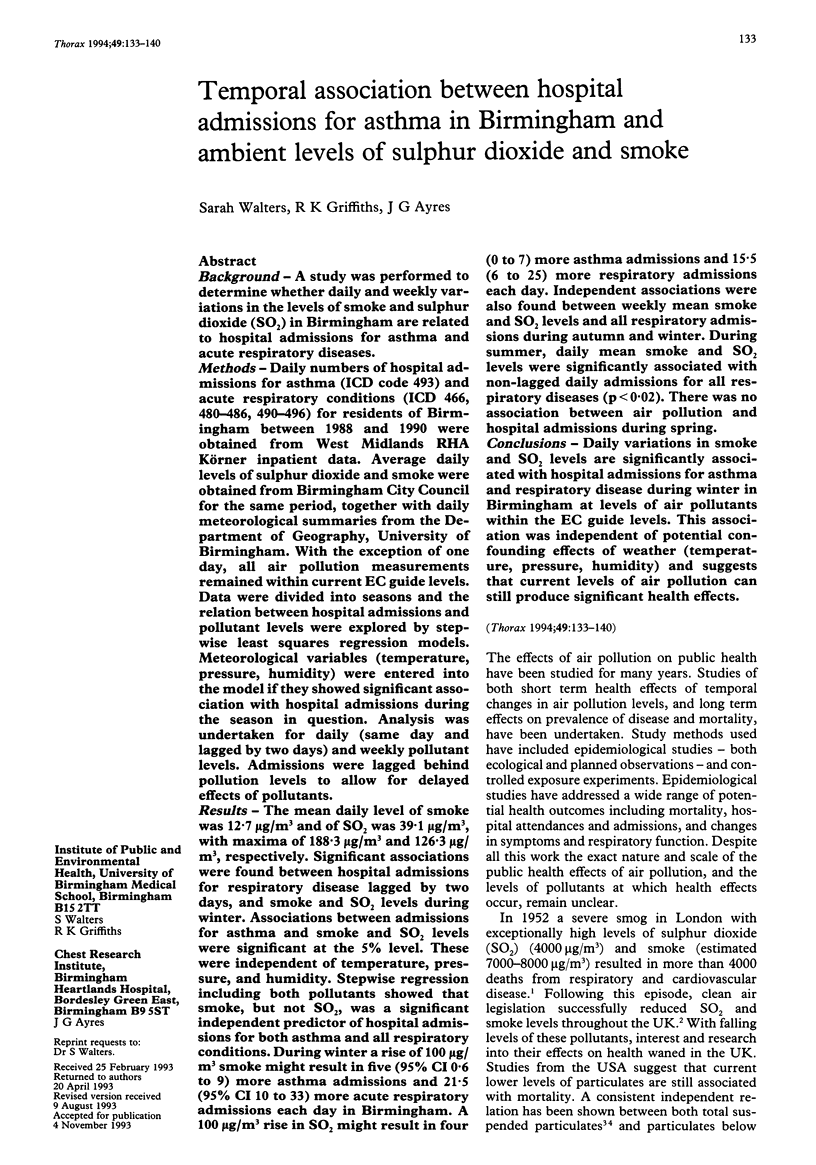
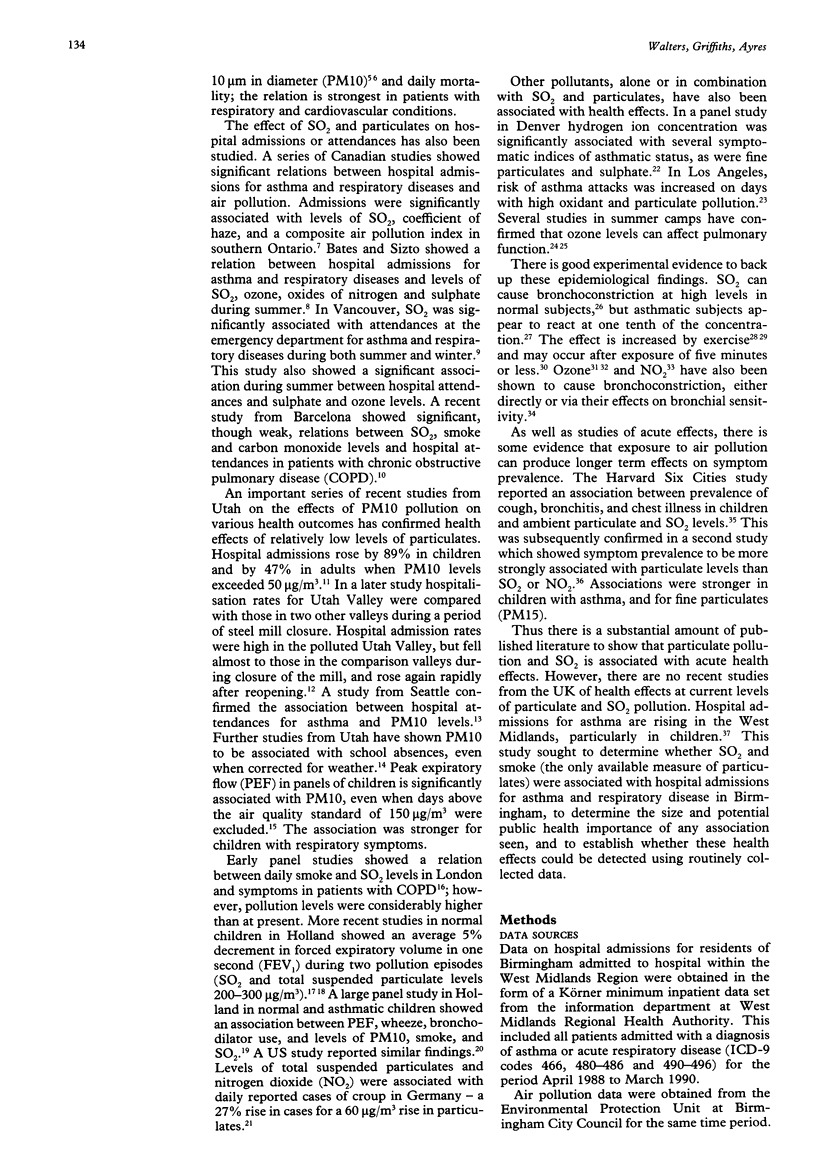
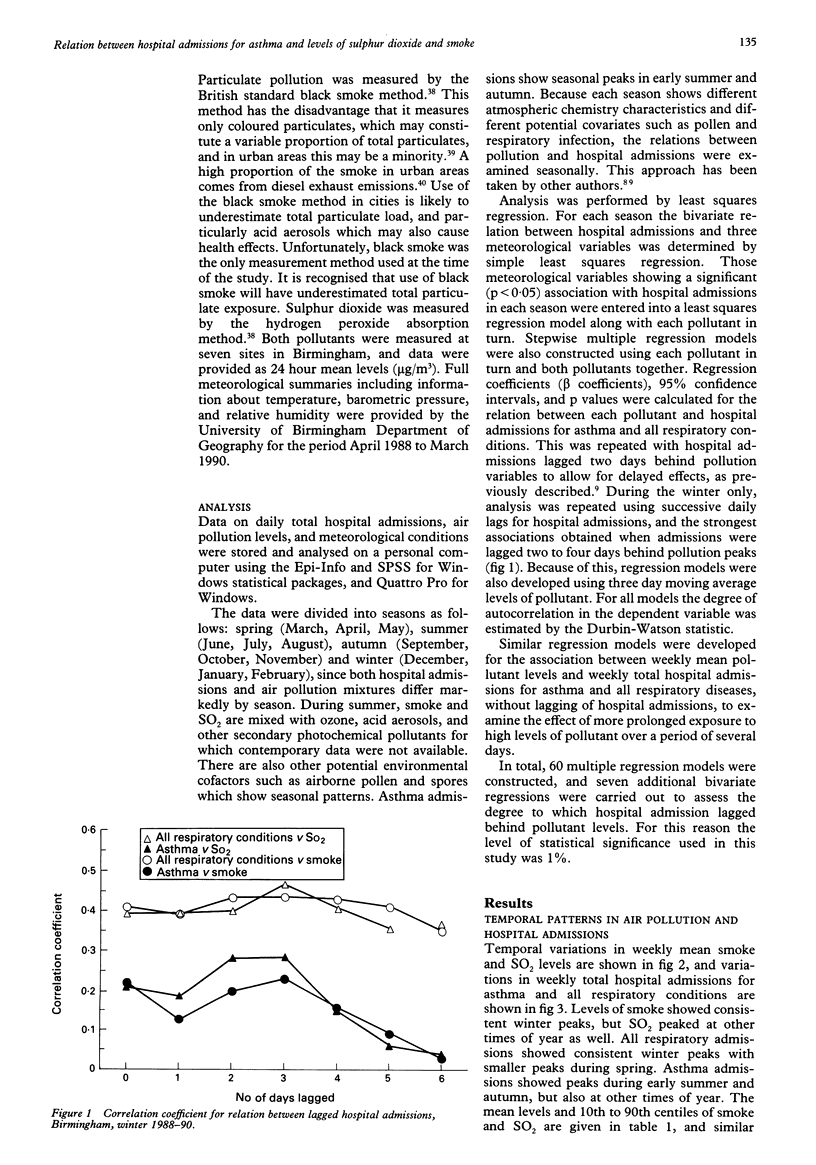
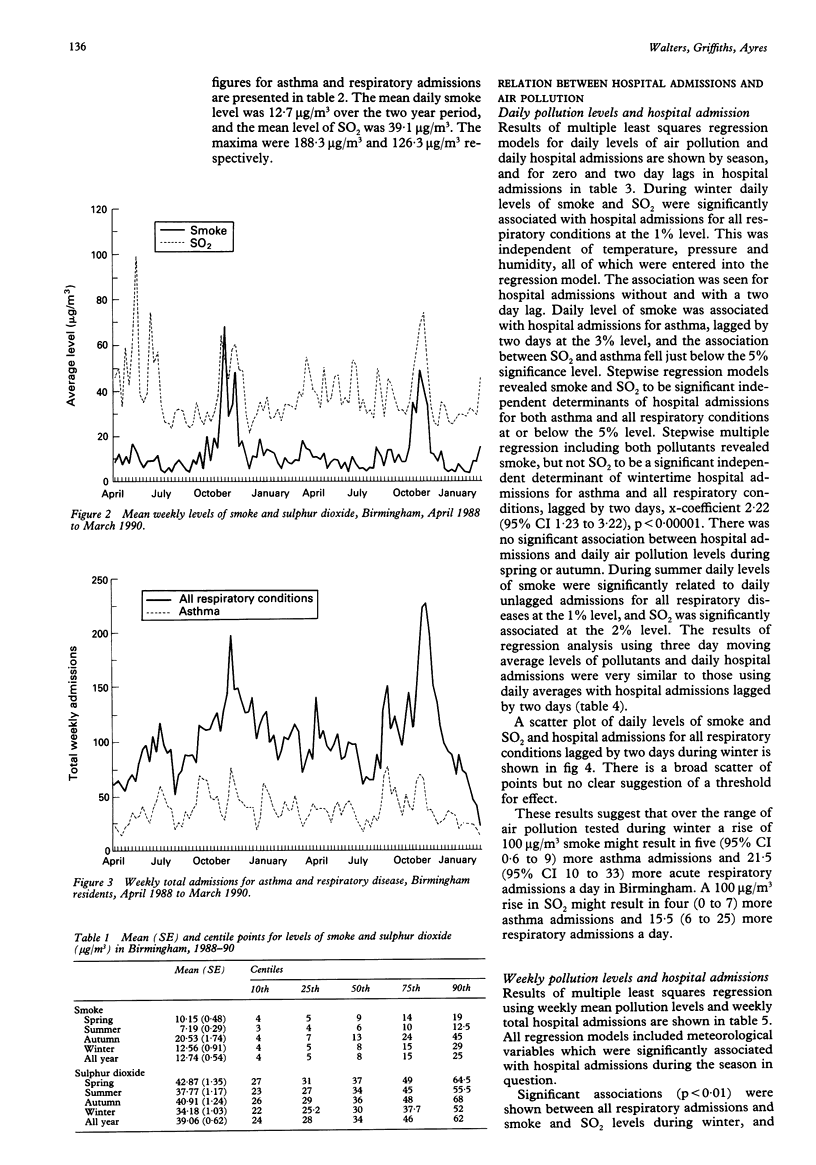
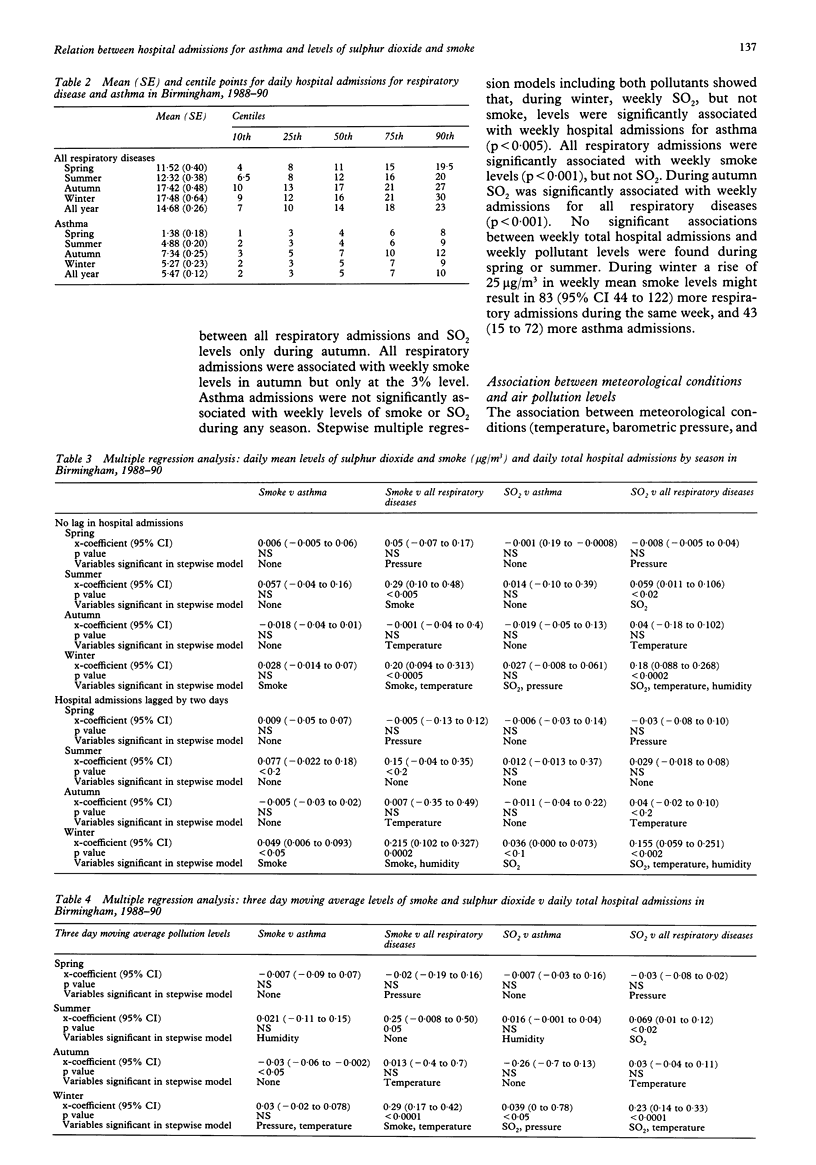
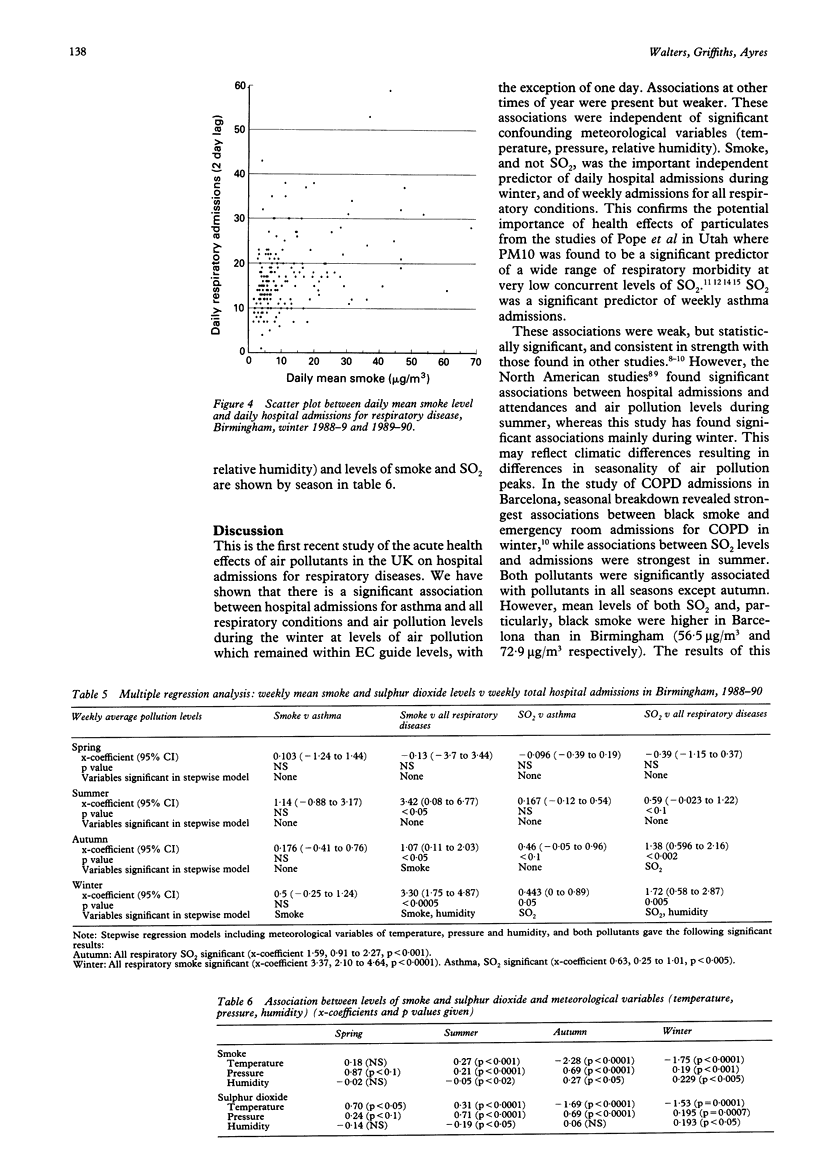
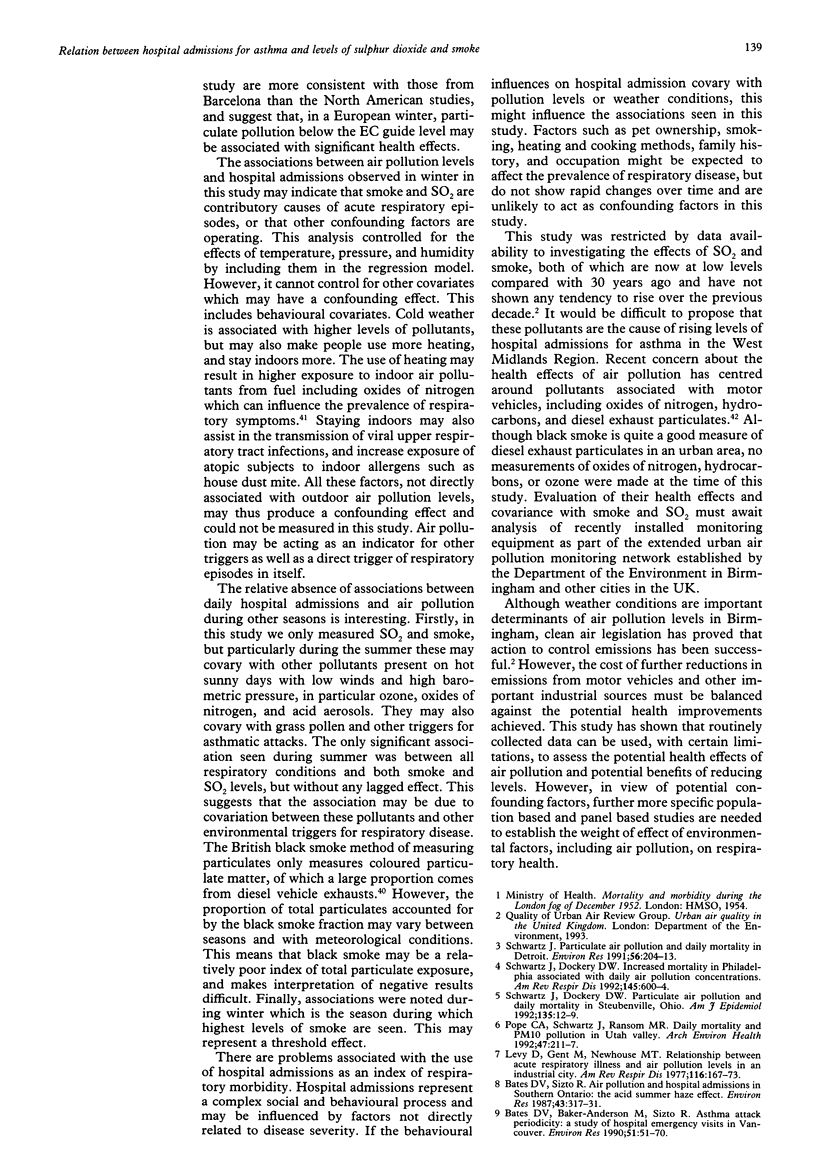
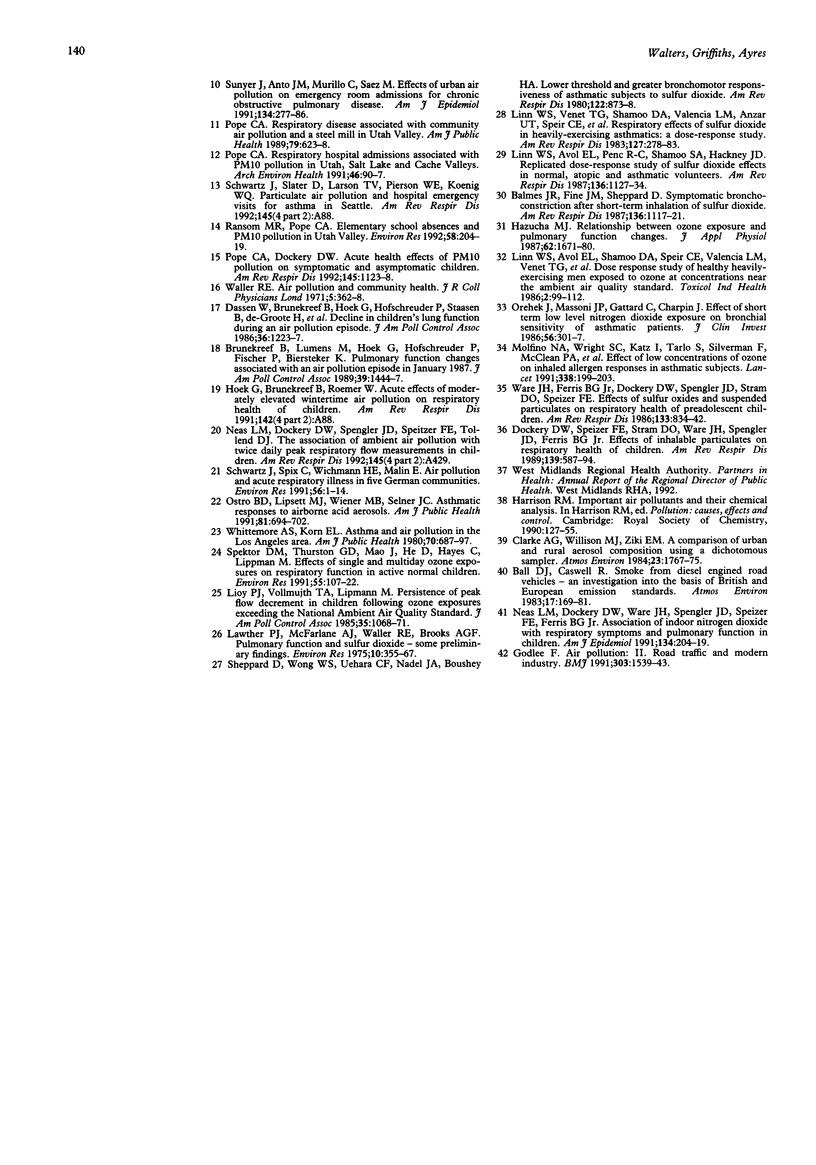
Selected References
These references are in PubMed. This may not be the complete list of references from this article.
- Balmes J. R., Fine J. M., Sheppard D. Symptomatic bronchoconstriction after short-term inhalation of sulfur dioxide. Am Rev Respir Dis. 1987 Nov;136(5):1117–1121. doi: 10.1164/ajrccm/136.5.1117. [DOI] [PubMed] [Google Scholar]
- Bates D. V., Baker-Anderson M., Sizto R. Asthma attack periodicity: a study of hospital emergency visits in Vancouver. Environ Res. 1990 Feb;51(1):51–70. doi: 10.1016/s0013-9351(05)80182-3. [DOI] [PubMed] [Google Scholar]
- Bates D. V., Sizto R. Air pollution and hospital admissions in Southern Ontario: the acid summer haze effect. Environ Res. 1987 Aug;43(2):317–331. doi: 10.1016/s0013-9351(87)80032-4. [DOI] [PubMed] [Google Scholar]
- Brunekreef B., Lumens M., Hoek G., Hofschreuder P., Fischer P., Biersteker K. Pulmonary function changes associated with an air pollution episode in January 1987. JAPCA. 1989 Nov;39(11):1444–1447. doi: 10.1080/08940630.1989.10466638. [DOI] [PubMed] [Google Scholar]
- Dassen W., Brunekreef B., Hoek G., Hofschreuder P., Staatsen B., de Groot H., Schouten E., Biersteker K. Decline in children's pulmonary function during an air pollution episode. J Air Pollut Control Assoc. 1986 Nov;36(11):1223–1227. doi: 10.1080/00022470.1986.10466168. [DOI] [PubMed] [Google Scholar]
- Dockery D. W., Speizer F. E., Stram D. O., Ware J. H., Spengler J. D., Ferris B. G., Jr Effects of inhalable particles on respiratory health of children. Am Rev Respir Dis. 1989 Mar;139(3):587–594. doi: 10.1164/ajrccm/139.3.587. [DOI] [PubMed] [Google Scholar]
- Godlee F. Air pollution: II--Road traffic and modern industry. BMJ. 1991 Dec 14;303(6816):1539–1543. doi: 10.1136/bmj.303.6816.1539. [DOI] [PMC free article] [PubMed] [Google Scholar]
- Hazucha M. J. Relationship between ozone exposure and pulmonary function changes. J Appl Physiol (1985) 1987 Apr;62(4):1671–1680. doi: 10.1152/jappl.1987.62.4.1671. [DOI] [PubMed] [Google Scholar]
- Lawther P. J., Macfarlane A. J., Waller R. E., Brooks A. G. Pulmonary function and sulphur dioxide, some preliminary findings. Environ Res. 1975 Dec;10(3):355–367. doi: 10.1016/0013-9351(75)90031-6. [DOI] [PubMed] [Google Scholar]
- Levy D., Gent M., Newhouse M. T. Relationship between acute respiratory illness and air pollution levels in an industrial city. Am Rev Respir Dis. 1977 Aug;116(2):167–173. doi: 10.1164/arrd.1977.116.2.167. [DOI] [PubMed] [Google Scholar]
- Linn W. S., Avol E. L., Peng R. C., Shamoo D. A., Hackney J. D. Replicated dose-response study of sulfur dioxide effects in normal, atopic, and asthmatic volunteers. Am Rev Respir Dis. 1987 Nov;136(5):1127–1134. doi: 10.1164/ajrccm/136.5.1127. [DOI] [PubMed] [Google Scholar]
- Linn W. S., Avol E. L., Shamoo D. A., Spier C. E., Valencia L. M., Venet T. G., Fischer D. A., Hackney J. D. A dose-response study of healthy, heavily exercising men exposed to ozone at concentrations near the ambient air quality standard. Toxicol Ind Health. 1986 Jul;2(1):99–112. doi: 10.1177/074823378600200105. [DOI] [PubMed] [Google Scholar]
- Linn W. S., Venet T. G., Shamoo D. A., Valencia L. M., Anzar U. T., Spier C. E., Hackney J. D. Respiratory effects of sulfur dioxide in heavily exercising asthmatics. A dose-response study. Am Rev Respir Dis. 1983 Mar;127(3):278–283. doi: 10.1164/arrd.1983.127.3.278. [DOI] [PubMed] [Google Scholar]
- Molfino N. A., Wright S. C., Katz I., Tarlo S., Silverman F., McClean P. A., Szalai J. P., Raizenne M., Slutsky A. S., Zamel N. Effect of low concentrations of ozone on inhaled allergen responses in asthmatic subjects. Lancet. 1991 Jul 27;338(8761):199–203. doi: 10.1016/0140-6736(91)90346-q. [DOI] [PubMed] [Google Scholar]
- Neas L. M., Dockery D. W., Ware J. H., Spengler J. D., Speizer F. E., Ferris B. G., Jr Association of indoor nitrogen dioxide with respiratory symptoms and pulmonary function in children. Am J Epidemiol. 1991 Jul 15;134(2):204–219. doi: 10.1093/oxfordjournals.aje.a116073. [DOI] [PubMed] [Google Scholar]
- Ostro B. D., Lipsett M. J., Wiener M. B., Selner J. C. Asthmatic responses to airborne acid aerosols. Am J Public Health. 1991 Jun;81(6):694–702. doi: 10.2105/ajph.81.6.694. [DOI] [PMC free article] [PubMed] [Google Scholar]
- Pope C. A., 3rd, Dockery D. W. Acute health effects of PM10 pollution on symptomatic and asymptomatic children. Am Rev Respir Dis. 1992 May;145(5):1123–1128. doi: 10.1164/ajrccm/145.5.1123. [DOI] [PubMed] [Google Scholar]
- Pope C. A., 3rd Respiratory disease associated with community air pollution and a steel mill, Utah Valley. Am J Public Health. 1989 May;79(5):623–628. doi: 10.2105/ajph.79.5.623. [DOI] [PMC free article] [PubMed] [Google Scholar]
- Pope C. A., 3rd Respiratory hospital admissions associated with PM10 pollution in Utah, Salt Lake, and Cache Valleys. Arch Environ Health. 1991 Mar-Apr;46(2):90–97. doi: 10.1080/00039896.1991.9937434. [DOI] [PubMed] [Google Scholar]
- Pope C. A., 3rd, Schwartz J., Ransom M. R. Daily mortality and PM10 pollution in Utah Valley. Arch Environ Health. 1992 May-Jun;47(3):211–217. doi: 10.1080/00039896.1992.9938351. [DOI] [PubMed] [Google Scholar]
- Ransom M. R., Pope C. A., 3rd Elementary school absences and PM10 pollution in Utah Valley. Environ Res. 1992 Aug;58(2):204–219. doi: 10.1016/s0013-9351(05)80216-6. [DOI] [PubMed] [Google Scholar]
- Schwartz J., Dockery D. W. Increased mortality in Philadelphia associated with daily air pollution concentrations. Am Rev Respir Dis. 1992 Mar;145(3):600–604. doi: 10.1164/ajrccm/145.3.600. [DOI] [PubMed] [Google Scholar]
- Schwartz J., Dockery D. W. Particulate air pollution and daily mortality in Steubenville, Ohio. Am J Epidemiol. 1992 Jan 1;135(1):12–25. doi: 10.1093/oxfordjournals.aje.a116195. [DOI] [PubMed] [Google Scholar]
- Schwartz J. Particulate air pollution and daily mortality in Detroit. Environ Res. 1991 Dec;56(2):204–213. doi: 10.1016/s0013-9351(05)80009-x. [DOI] [PubMed] [Google Scholar]
- Schwartz J., Spix C., Wichmann H. E., Malin E. Air pollution and acute respiratory illness in five German communities. Environ Res. 1991 Oct;56(1):1–14. doi: 10.1016/s0013-9351(05)80104-5. [DOI] [PubMed] [Google Scholar]
- Sheppard D., Wong W. S., Uehara C. F., Nadel J. A., Boushey H. A. Lower threshold and greater bronchomotor responsiveness of asthmatic subjects to sulfur dioxide. Am Rev Respir Dis. 1980 Dec;122(6):873–878. doi: 10.1164/arrd.1980.122.6.873. [DOI] [PubMed] [Google Scholar]
- Spektor D. M., Thurston G. D., Mao J., He D., Hayes C., Lippmann M. Effects of single- and multiday ozone exposures on respiratory function in active normal children. Environ Res. 1991 Aug;55(2):107–122. doi: 10.1016/s0013-9351(05)80167-7. [DOI] [PubMed] [Google Scholar]
- Sunyer J., Antó J. M., Murillo C., Saez M. Effects of urban air pollution on emergency room admissions for chronic obstructive pulmonary disease. Am J Epidemiol. 1991 Aug 1;134(3):277–289. doi: 10.1093/oxfordjournals.aje.a116081. [DOI] [PubMed] [Google Scholar]
- Waller R. E. Air pollution and community health. J R Coll Physicians Lond. 1971 Jul;5(4):362–368. [PMC free article] [PubMed] [Google Scholar]
- Ware J. H., Ferris B. G., Jr, Dockery D. W., Spengler J. D., Stram D. O., Speizer F. E. Effects of ambient sulfur oxides and suspended particles on respiratory health of preadolescent children. Am Rev Respir Dis. 1986 May;133(5):834–842. [PubMed] [Google Scholar]
- Whittemore A. S., Korn E. L. Asthma and air pollution in the Los Angeles area. Am J Public Health. 1980 Jul;70(7):687–696. doi: 10.2105/ajph.70.7.687. [DOI] [PMC free article] [PubMed] [Google Scholar]


